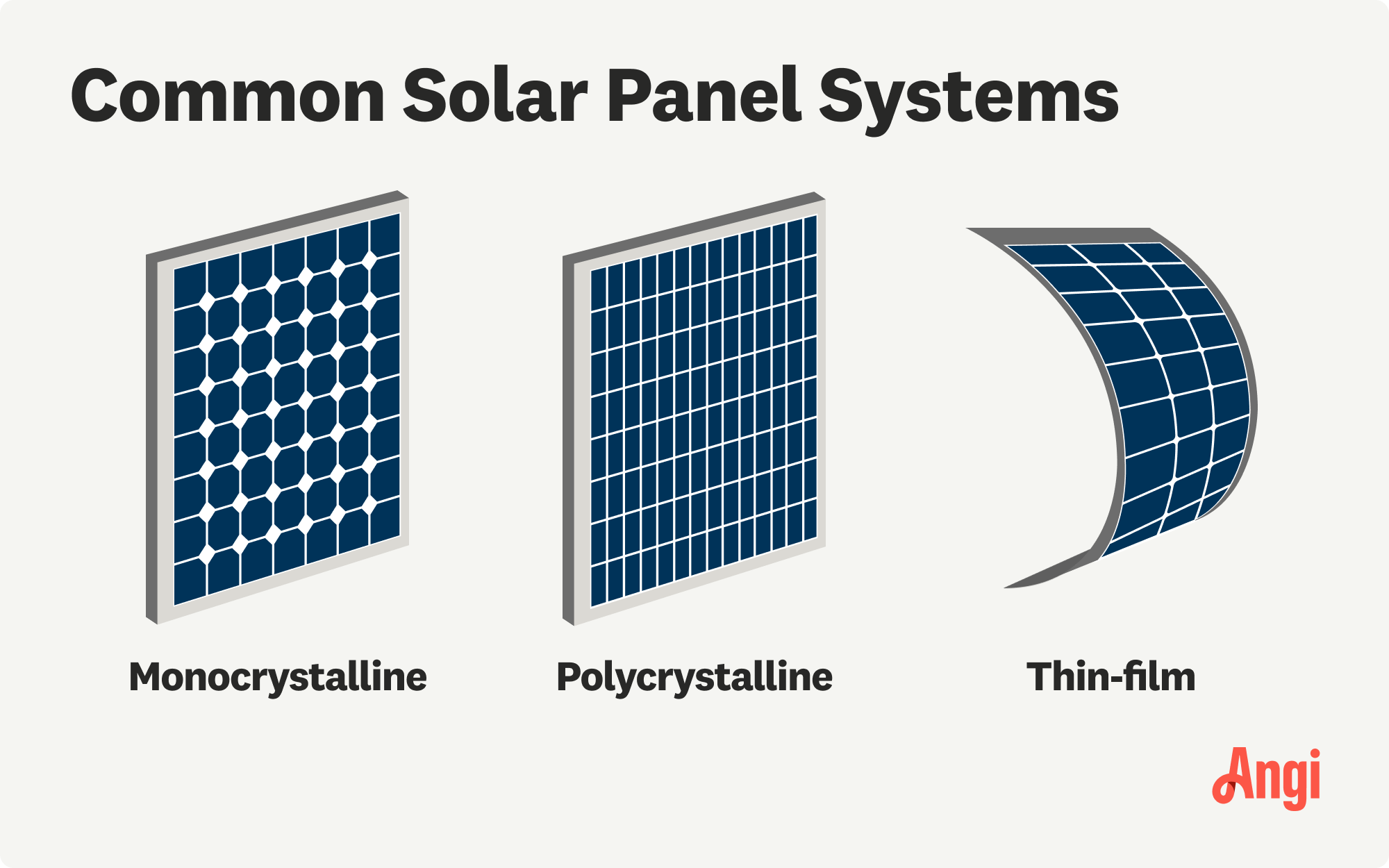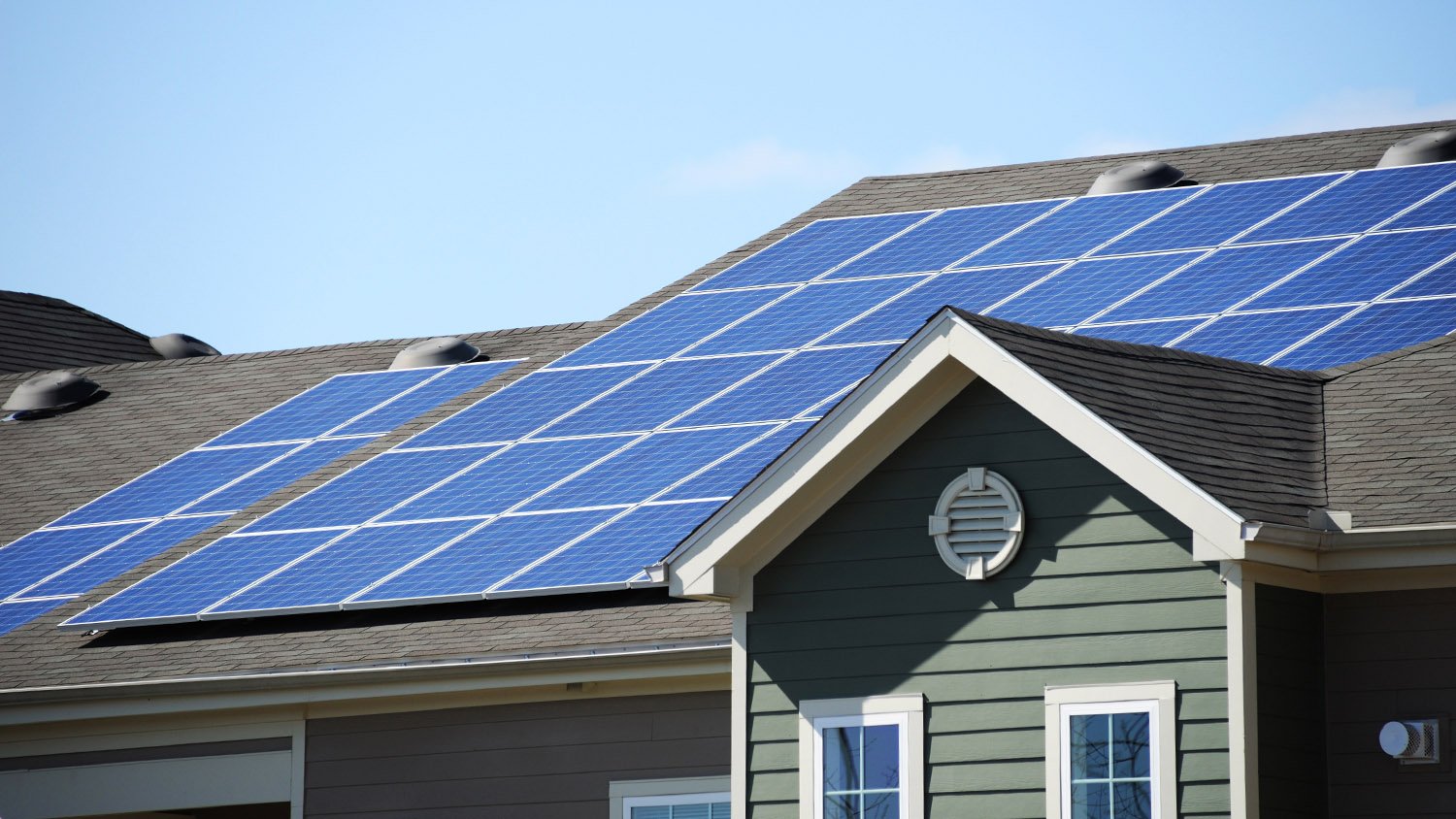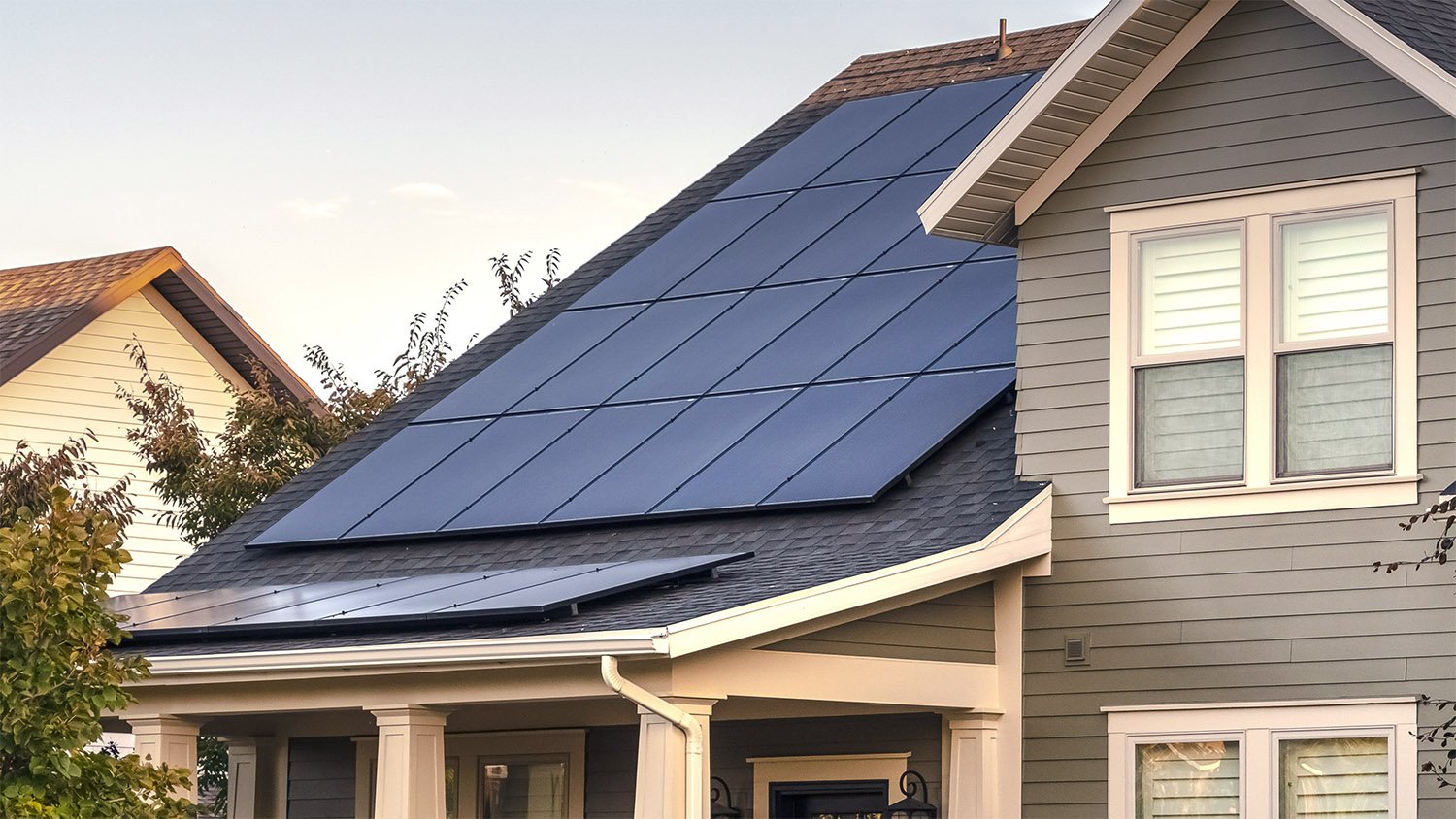
Solar battery costs depend on the size of your system, labor, and capacity. Learn how much you could pay for batteries for home solar systems.
Getting the most out of your solar panels is a power move


If hot, sunny days inspire you to switch to renewable energy for your home, it might be time to take the plunge. Before you can admire a shiny, new solar panel system on your roof, you need to choose between the different types of solar panels. Check out the advantages and disadvantages of each of the three types—monocrystalline, polycrystalline, and thin-film—and get answers to your questions about going solar.

Monocrystalline panels are the technology that started it all. These panels originated in the 1950s, and they’re still going strong in the solar world. Each solar cell in a monocrystalline solar panel is made from a single silicon crystal and looks like a wafer. A monocrystalline panel is made up of multiple wafers.
There are a few benefits and disadvantages of monocrystalline solar panels. They’re the most energy-efficient, with ratings that can soar above 20%—especially if you choose a half-cut or PERC (passivated emitter and rear cell) panel. Half-cut panels contain twice the number of solar cells in the space of a standard-sized panel. It’s also an ideal solar panel for areas with darker winters. On the other hand, they’re more expensive than other options.
| Pros | Cons |
|---|---|
| Highest efficiency (15%–25%) | Highest up-front costs |
| Requires less space and fewer panels | Less sustainable manufacturing process |
| Performs well in lower-light situations | Limited dimensions available |
| 40-year life span with a 25-year warranty | Loses more efficiency in shade |
| More efficient in heat | |
| PERC panels can have an extra 5% efficiency |

Monocrystalline and polycrystalline panels are both manufactured from silicon. However, instead of cutting a single silicon crystal into wafer shapes, manufacturers form polycrystalline panels by melting silicon fragments and pouring the molten silicon into a square-shaped mold.
Because of their construction, polycrystalline panels are more affordable. They also perform better in shaded areas, though neither monocrystalline nor polycrystalline panels work well when significantly shaded. At the same time, they have lower efficiency and a shorter life span.
| Pros | Cons |
|---|---|
| More affordable | Lower efficiency (13%–17%) |
| Last up to 25 years | Requires more space and panels |
| Most manufacturers offer a 25-year warranty | Less efficient in heat |
| More efficient in minor shade | Wears faster with stress or temperature changes |
| More sustainable manufacturing process | Blue color stands out on black or gray roofing |

Also known as thin-film photovoltaic cells or thin-film PV, the third type of solar panel is made differently than monocrystalline and polycrystalline panels. Manufacturers construct thin-film solar panels by putting down layers upon layers of photovoltaic materials, such as copper indium gallium selenide (CIGS), cadmium telluride, or amorphous silicon. Because these panels take up significantly more space to generate energy than other kinds, thin-film panels are often used in industrial settings rather than residential ones.
Remember, solar panels can be dangerous to install, so regardless of which type you choose, consult a local solar installation pro who can help you safely switch to solar.
| Pros | Cons |
|---|---|
| Best option for shade and low light | Lowest efficiency (7%–14%) |
| Lightweight | Requires a large amount of space |
| Performs well in high heat | Shorter life span (10–20 years) |
| Easier to install or move | Higher cost because you need more panels |
| Ideal for commercial applications | May not be suitable for residential buildings |
For homeowners making the jump to sustainable energy, solar power comes with a long list of pros and cons. Efficiency is at the very top. Without it, you won’t see meaningful energy savings. You’re best served by choosing the highest efficiency panel in your budget as long as it works with your climate and the light conditions in your yard.
| Type of Solar Panel | Efficiency |
|---|---|
| PERC | Up to 25% |
| Monocrystalline | 15%–25% |
| Polycrystalline | 13%–17% |
| Copper indium gallium selenide (CIGS) | 13%–15% |
| Cadmium telluride (CdTe) | 9%–11% |
| Amorphous silicon (a-Si) | 6%–8% |
PERC panels (passivated emitter and rear cell panels) have up to 25% efficiency. These panels use monocrystalline solar cells—they’re just a highly efficient upgrade to classic solar energy technology. PERC panels are 5% more efficient than traditional monocrystalline panels.
These panels include an extra layer on the back of each cell. The extra layer helps reflect light at a wavelength the cell can more readily absorb and prevents blockages that inhibit the free movement of electrons.
Traditional monocrystalline panels have anywhere from a 15% to 23% efficiency rating. This is one of the most common panels used in residential applications, but the efficiency comes with a higher price tag.
Polycrystalline panels offer 13% to 17% efficiency. They’re a wallet-friendly alternative to monocrystalline panels and perform better in partially shaded situations.
Copper indium gallium selenide (CIGS) panels are a type of thin-film panel with an efficiency most comparable to traditional monocrystalline or polycrystalline panels. CIGS panels have 13% to 15% efficiency—though lab tests have shown some panels can achieve 22% efficiency. Since they contain toxic materials, you’ll need to be careful when disposing of them.
Cadmium telluride (CdTe) panels are another type of thin-film panel. These panels have 9% to 11% efficiency. Even though they’re less efficient, they’re more resilient in lower-light situations. These solar panels are made of cadmium, a toxic heavy metal. You’ll need to be careful how you dispose of your panels at the end of their life span.
Amorphous silicon (a-Si) panels are also thin-film solar panels. On average, they have 6% to 8% efficiency. Despite their low efficiency, these panels offer a range of benefits. They are affordable, flexible, less likely to crack, perform well in lower-light situations, have a higher heat tolerance, and maintain eligibility for the federal solar tax credit.
You’ll commonly find a-Si panels used in small-scale applications with lots of surface area, like on greenhouses.
The cost to install solar panels is between $18,400 and $36,400 before the 30% federal tax credit. The type of solar panel is a large factor in the overall cost. The higher the efficiency of the panel, the more it will cost up front, but prices are consistently shrinking as solar technology evolves.
| Type of Solar Panel | Cost per Watt | Average Cost (6-kW system) |
|---|---|---|
| Monocrystalline panels | $1–$1.50 | $6,000–$9,000 |
| Polycrystalline panels | $0.90–$1 | $5,400–$6,000 |
| Thin-film panels | $0.50–$1.50 | $3,000–$9,000 |
Monocrystalline panels are the most expensive type of panel. Expect to spend anywhere from $1 to $1.50 per watt. The average 6-kilowatt (kW) system costs $6,000 to $9,000, excluding labor and additional materials. Certain higher-efficiency monocrystalline panels (like PERC panels) cost less per watt because each panel offers more power.
Polycrystalline panels are an affordable alternative to monocrystalline panels. They cost $0.90 to $1 per watt. The average 6-kW system costs $5,400 to $6,000, excluding labor and additional materials.
Thin-film panels are a middle ground. They can be less expensive than other panels, but you’ll need more panels for the same amount of power, which can increase the cost of your system. Expect to spend anywhere from $0.50 to $1.50 per watt or $3,000 to $9,000 for a 6-kW system.
Most homes are good for solar energy, but you’ll need to choose the right solar panel to reap the cost savings. Ideally, your panels should be able to handle your climate and the level of sunlight on your property with the highest efficiency possible. Here are some factors to consider:
Consider the life span of your solar panels and how it contributes to long-term costs. You’ll spend more if your polycrystalline panels only last 20 years and you need to replace them than if you had installed monocrystalline panels that last 40 years. Proper maintenance can make your panels last as long as possible.
Your roof needs the space to accommodate enough solar panels to power your home. You can mount solar panels on the ground instead of the roof if you have a small roof. Either way, higher-efficiency panels require less space. If you have a large roof, you can choose a less efficient panel (which takes up more space) at a more budget-friendly cost.
When considering solar panels, you’ll need to assess your roof's age, size, pitch, and shape. The trees shading your home will also impact whether rooftop solar panels are the best option. A solar panel installation pro can assess your roof and recommend the next steps.
Your solar panels need to withstand the weather and climate in your area, including extreme weather like hurricanes, hail storms, and wildfires. Make sure your panels have the required or recommended rating.
For example, areas prone to wildfires require a Class A (the highest) fire rating. Similarly, if you live in an area with hail storms, you can use a crystalline panel that can handle hail at speeds of 50 mph rather than a flexible thin-film panel that’s prone to impact damage.
Though there is no official hurricane rating for solar panels, certain installation methods can help safeguard your panels against this extreme weather, including installing reinforced mounting and adding protective covers.
Though the sun helps your solar panels create electricity, the constant UV rays and temperature fluctuations degrade them over time. The average degradation rate for solar panels is around 0.50% efficiency annually, but the highest quality panels degrade 0.30% year over year.
The temperature of your solar panels impacts their ability to produce electricity. Solar panels are tested to remain at peak efficiency between 59 and 95 degrees Fahrenheit. The further the temperature goes out of that range, the more efficiency your panels will lose. This effect is known as the temperature coefficient.
The higher the temperature coefficient, the worse your panel performs under extreme temperatures. If you live in a hot climate, choose a panel with a low temperature coefficient, like monocrystalline panels.
From average costs to expert advice, get all the answers you need to get your job done.

Solar battery costs depend on the size of your system, labor, and capacity. Learn how much you could pay for batteries for home solar systems.

Get a clear estimate for solar water heater repair cost. Learn what impacts pricing and how to budget for your solar water heater repair.

Get a detailed estimate of solar farm costs. Learn about average prices, key cost factors, and ways to save when planning your solar farm project.

Are there roof replacements that include solar? Get the facts here and learn whether you should replace your roofing before installing solar panels.

Discover the top 10 states with the best infrastructure for solar panels and find out if solar will work for your home.

Solar panels offer instant savings on your monthly energy bill. But how much money do solar panels save, really? Learn about solar panel savings in this guide.